The Evolution, Appeal, and Inevitability of Video Podcasts
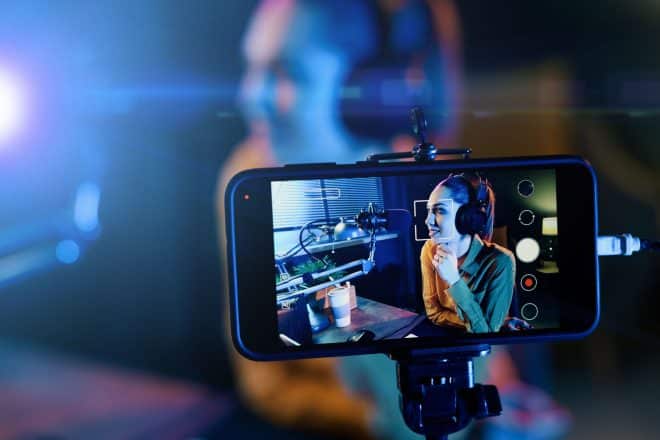
Last updated on November 12th, 2023
In an age where digital content is available in so many different formats, it’s critical to not only inform but engage your audience. So… just how do you decide how to do that?
*Record Scratch* – who are we kidding? This is digital y’all. This ain’t no static image. But… Just one more thing…
Enter the realm of video podcasting – a digital revolution in its own right and our favorite medium for engaging an audience. But are they inevitable? Are they even podcasts?
Starting as an audio-only format, podcasts offered a hands-free way to consume content, whether you were commuting, exercising, or simply relaxing. Audio only because the iPods they were initially meant for had monochromatic screens. A far cry from the myriad of options we have available to us today, right?
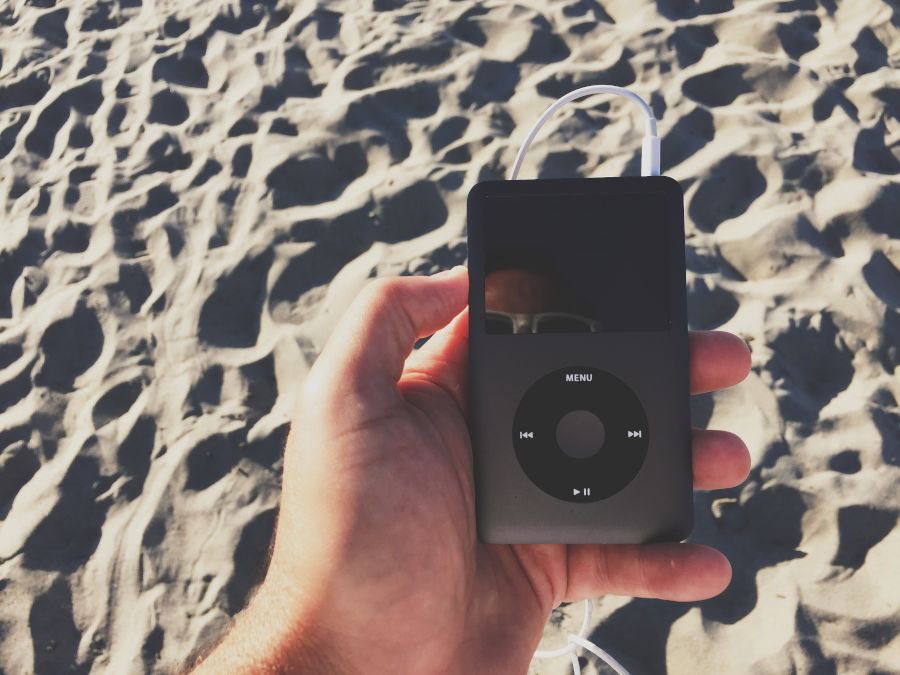
However, as with most media, evolution is inevitable. Naturally, a significant shift has occurred, leading to the rise of video podcasts. This format, as the name implies, brings a visual element to what had always been audio first (if not audio only).
While the core principle remains the same, video taps into a more interactive, visually stimulating realm of content delivery.
The growth of video podcasting is not merely a trend but a testament to the changing dynamics of content consumption. People are no longer just listeners; they’re viewers, participants, and critics, all at once.
This dual format of auditory and visual content appeals to a more diverse audience, catering to their listening preferences.
But does this pollute and poison audio podcasts? Is adding video to podcasting healthy for our industry?
As we dive deeper into this topic, we’ll uncover the history, advantages, disadvantages, and the profound impact video has in today’s digital era.
Table of Contents
A Brief History of Podcasts
There’s a solid chance if you’re on our site, you know this already. But for you young whippersnappers who have never known anything but video, here’s a brief look at our antiquated past.
At first, podcasts were just audio, meaning you could only listen. Podcasts first showed up on the scene as early as 2004 when the internet didn’t have the bandwidth for mobile streaming video, and devices didn’t have the storage to really carry much more than audio.
I mean, could you imagine how much cellular data you would be using watching live streaming video? That bill would have been enormous. The technology just wasn’t there. So we had this budding audio format that Apple created.
We still use the term podcast today, no matter how you’re listening or on what device. But just look at the term. It’s a mash-up of “pod” from the iPod and “broadcast.”So at the time, the only podcasts available were purely audio.
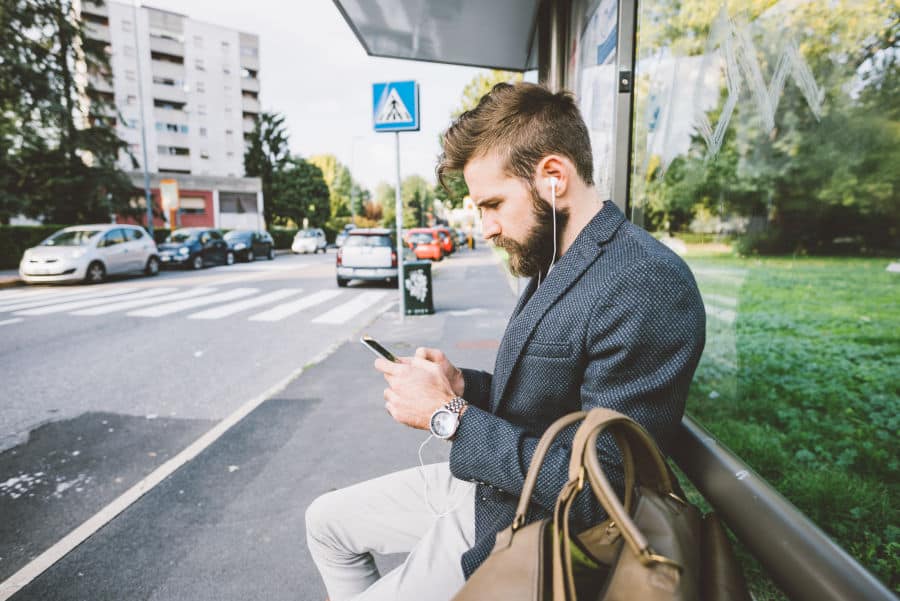
But as the internet got faster and better, video started to appear around the mid-2000s, and many creators were working in both mediums. It’s kind of like watching a TV show but on your computer or phone. In 2005, Apple did something big: they added podcasts to iTunes. iTunes was a place where people got their music, movies, and more. So, when podcasts, including video ones, joined the party, they got even more popular.
It got easier to find a podcast platform, remote recording became possible, and it was now easier to create videos.
As bandwidth on the internet increased exponentially, and especially on mobile devices with 3G, 4G, and 5G evolved, so too did video podcasts.
The Marriage of Podcasts and Video: Why it Works
If you’ve ever wondered, “Why are video podcasts becoming so popular?” The answer lies in the way we’ve evolved in how we consume media. If you are an audio-only podcaster, this question has become ever more existentially troubling.
It’s a bit like how we went from just reading books to watching movies; both have their own charm, but movies add a visual layer to the story. Audiences love video content.
People don’t read as much, and movie or television adaptations of underlying written material are more popular and profitable than ever.
Basically, the same thing here. As mentioned before, as bandwidth increased and recording video became more affordable, appealing to an audience’s love of visual stimulus was sort of the natural evolution. It allowed content creators to reach those who like audio as well as video. As of 2022, that’s most people.
An audio podcast alone doesn’t cast as wide a net.
The marriage of podcasts and video allows creators to reach a bigger potential podcast audience. Audience growth is the name of the game, right?
But making a great video or a successful video isn’t necessarily easy.
Advantages and Disadvantages of Video Podcasts
Podcasts have become a popular way for people to learn new things, hear stories, or simply be entertained. And while many podcasts are just audio, a growing number are also using video.
Video can be a double-edged sword when it comes to format choices. Your whole podcast setup has to change. So let’s look at the pros and cons of adding video to your podcasting plan.
Pros of Video Podcasts
Video certainly has some potential advantages that can’t be brushed off.
Visual Aids Support the Message:
This is one I’m “seeing” (yeah, I did it) a lot lately. I’ll be listening to a podcast in the car on a commute, and the host will reference something visual, or they’ll watch part of a video and tell the listener to “check out the video” to understand that part of the podcast episode.
Sometimes I think that turns the podcast audio audience into second-class citizens. But there’s no denying there are upsides to visual aids.
Let’s say you’re watching a podcast about how to make a cake. It’s much easier to understand when you see the steps in action, from mixing the batter to decorating the finished product. Visuals can clarify complicated topics or simply add more depth to a story.
We aren’t linking this, because, you know… think of the children. But…
Some shows lend themselves more to a visual aid. I want to see Elon smoke that joint on Joe Rogan, dammit. I don’t want just to hear him giggle and spout nonsense. I need to see that. Need.
Enhanced Engagement with Viewers: Have you ever heard the saying, “A picture is worth a thousand words”? Video podcasting can be even more powerful… as illustrated by the Elon Musk example.
By seeing the host, viewers can feel more connected to the content. I think is one of the reasons why Joe Rogan has been as popular as he is. People know exactly what he and his guests look like. They can see the banter and interaction. It’s sometimes more intimate.
It’s like the difference between reading a book and watching a movie. Both are great, but movies can make you feel like you’re right there in the action.
Greater Social Media Potential: So much of social media is now video-based. Especially short videos. TikTok, YouTube (which we’ll address in detail shortly), Shorts, Facebook, and whatever Instagram is up to… the short video trend is exploding.
If you’ve already shot your podcast recording with video, it’s easy to edit out a snippet to share with the world and entice someone with a few seconds of video to come and consume the whole enchilada.
So, the video recording can be used for a whole host of additional marketing purposes above and beyond the primary show itself.
Cons of a Video Podcast
But it’s not always a bed of roses. Sometimes a video is no pleasure cruise. At all. There are several potential pitfalls when entering into a video adventure.
More Resources and Video Podcast Equipment: Audio requires some basic equipment: a good microphone, some recording software, and maybe some soundproofing. Really, you can get started for potentially a hundred bucks.
For video? You’ll need a whole lot more.
To record video, you’ll need cameras, lighting, maybe a backdrop, and more advanced video editing software. This can be pricier and trickier to learn. You may need some crew. And that’s just for an in-studio recording.
If you’re doing a remote interview on video, that’s a whole other ball of wax.
And bandwidth. When you’re using video, your hosting is likely going to get more expensive. Especially as your show grows. So even after you’ve invested more in your gear, you may have more ongoing costs associated with a video podcast.
Editing Takes Longer: Editing audio can be pretty straightforward. Audio podcast editing can be done on free software, you can cut out dead air and splice together takes seamlessly. It just goes a lot faster, and you can fix a lot of mistakes. “Fix it in the mix!“
But when you create a video, things get complex in a hurry. You need to sync the audio with the video, ensure good video quality, add visuals, and more.
You can learn a lot of the skills required for video editing these days on a platform like Udemy or Skillshare, but it simply isn’t as easy as audio. Video podcast software is akin to adding another dimension to your art.
Being on Camera Isn’t for Everyone: While being on camera has its advantages, not everyone feels comfortable in the spotlight.
As someone with anxiety, I can understand people might feel nervous in front of a lens. Plus, there’s the added pressure of looking presentable on camera, which can be stressful. And a stressed-out host is not going to create the best video podcasts.
Some of us just prefer to remain anonymous.
YouTube: The Second Largest Search Engine
YouTube is certainly a “pro” when it comes to video, but it’s the 800-pound gorilla of the topic, so I thought it needed a little extra breakdown.
Google is the largest search engine. We know this. If you want to know something, you google it, right? It’s a verb. Okay, so what’s the second-largest search engine? YouTube. Which is owned by Google. So there’s massive integration and synergy there.
So much so that the United States is, as of the time of this writing, suing Google for anti-trust practices. But, at least for the time being, Google, and its video service, YouTube, can’t be ignored. Really, YouTube is where to watch video podcasts.
Google Podcasts for audio creators is a lackluster product. But for a video podcast creator, there are some compelling reasons to embrace the Alphabet gorilla.
Discoverability:
On YouTube, discoverability is a game-changer. Thanks to the platform’s powerful recommendation algorithms, once someone watches a video podcast episode, they’re likely to be suggested similar content or other episodes from the same podcaster. This means that even a newcomer to the podcasting scene can gain traction relatively quickly if their content resonates with viewers.
Hosting Benefits:
Searchability: By being the second largest search engine, YouTube provides a platform where your content can be actively searched for. With the right keywords, descriptions, and tags, your video podcast can be easily found by users searching for related topics.
Monetization: YouTube offers various monetization methods, from ad revenues to channel memberships. For podcasters, this can be a significant additional income source, especially when paired with traditional podcast monetization methods.
That’s why the phrase “smash those like and subscribe buttons” has become so you-biquitous. (Oops… I did it again. I… nevermind)
Engagement: The comment section on YouTube offers direct feedback from viewers. Podcasters can engage with their audience, answer questions, and even use the feedback to shape future episodes.
But, like, don’t read the comment section if you value your sanity and want to retain some semblance of confidence.
In essence, while Google remains the king of search, YouTube’s role as the second-in-command offers a vast ocean of possibilities for video podcasters. It’s not just about uploading content but about reaching a bigger audience who might not be on the traditional podcast platforms.
By leveraging YouTube’s vast user base, searchability, and monetization features, podcasters can cast a significantly wider net, tapping into audiences they might not have reached otherwise.
So you’ve got to ask yourself… Video has a lot of upsides, sure, but is it always appropriate?
Is Video Suitable for All Podcast Genres?
The realm of podcasting is diverse, encompassing everything from news updates to intricate storytelling. As video gains traction, a crucial question arises: “Is video appropriate for every podcast genre?”
The short answer is obviously no. But it’s a bit complicated.
Genres Excelling with Video:
Let’s look at some video podcast examples that do it right.
Interviews: Watching the back and forth of any interview can have some upsides when you add video. Seeing the dynamic exchanges on “First We Feast: Hot Ones” adds a visual layer to the experience. It’s one of the better, pure video examples. In fact, we talked about Sean’s interview techniques heavily in our post on that subject.
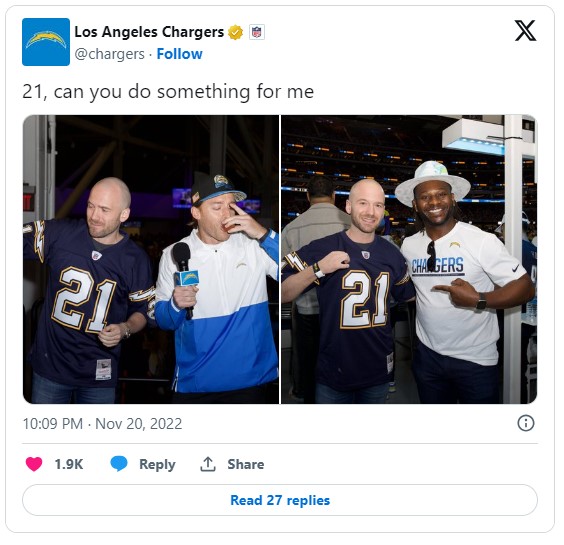
That show wouldn’t be the same without seeing the pain and coping techniques of the guests. Observing facial expressions and non-verbal cues enhances the connection between the viewer and the participants.
After all, interviews are not purely auditory. Nor should they be. Some studies cite nonverbal communication as 90% of what comes across. It goes, then, without saying that interviews are a type of podcast where video adds a significant advantage.
Product Reviews: Channels like “Unbox Therapy” or the MKBHD show from Vox visually showcase products, allowing viewers to see features, designs, and real-time demonstrations. A visual review can be far more informative than a mere verbal description. Even if we can’t touch it, we like to see what we’re buying.
I don’t care how descriptive your language is, the written word leaves a lot of room for the imagination to take over and fill gaps.
Visual Stories: Podcasts that focus on travel or visual arts, like “The Art History Babes,” thrive when visuals complement the narrative. Experiencing vibrant art pieces or picturesque landscapes can transport viewers, offering a richer experience than audio alone.
It’s not much different than a product review. Like Robin Williams’ character in Good Will Hunting, you can’t describe the Sistine Chapel. You have to see it. You have to be as immersed as you can be.
Visual stories are travel stories. These are the video podcast formats that work best.
When Audio Might Be the Upper Hand:
Look, we’re podcasters and podcast fanatics at heart. While there are a lot, and I mean a lot, of upsides to video, shoehorning video into a genre where it’s not welcome isn’t a good idea.
Certain podcast genres resonate more intimately in an audio-only format. Consider deep introspective narratives or rant-like monologues (Scott Galloway, or Sam Harris, hell, even some of the JRE backfires, and that’s our bread and butter).
Ambient soundscapes and guided meditations are obvious examples. I mean, your eyes are supposed to be closed.
How about the True Crime genre or anything fictional? Narrative storytelling works in the audio format. Think radio drama in the 30s. Nostalgia. Let it soak in.
Those stories resonated for a reason, and it wasn’t simply that the television camera hadn’t become mainstream yet. It worked for a reason unto itself.
Our imaginations haven’t been completely hollowed out. At least, I want to believe that.
Here, the absence of visuals encourages listeners to engage their imagination, immersing themselves deeper into the auditory experience.
Addressing the Core Question: Can a Podcast Be Done as a Video?
Definitely! But it’s pivotal to evaluate whether video enhances or detracts from the core message.
How many Moby Dick movie adaptions have we seen? How about Hamlet? I mean, the Lion King is an adaptation of Hamlet, right?
Uncle kills King, Son rises to meet the mantle. We’ve seen that. Podcasts are meant to break the mold.
Or at least wrest the audio narrative from the ground where and when appropriate.
While visuals can amplify engagement, there are instances where the essence of the content might be better conveyed through the intimacy of voice alone. Decisions about format should prioritize the integrity of the content and its intended impact on the audience. Poor Mufasa.
Ask yourself… would the book be better than the movie? If yes, video podcast. If the book would be better left to its own devices, then, no, stay audio. And yes, that cadence, while lame, was on purpose.
Getting Started with Video Podcasts
We’re not going to make the call for all you podcasters out there. Video is a big deal, but it isn’t for everyone. But, for those willing to push through the slog and ignore (and I stress, ignore) the comments, it can be done.
The allure of video podcasts is evident, bridging visual aesthetics with riveting audio content. For those poised on the edge, wondering, “How do I venture into video podcasting?” this section endeavors to shed light.
If we’re willing, as podcasters, to let that light shine, then let’s let it shine.
Basic Equipment and Setup:
To get going with video, you’re going to need a lot more than a microphone (though you will need that) and the right podcast software (though you’ll need the right podcast software as well).
Camera: A quality DSLR or mirrorless camera can work wonders. However, for beginners, even smartphones with good cameras can suffice. Remember, content is king, so while quality matters, it’s your message that takes center stage.
Microphone: Clear audio remains paramount in video podcasts. Invest in a quality condenser microphone that can capture crisp sound. Many podcasters vouch for the Yeti by Blue or the Audio-Technica AT2020 as reliable starters.
Lighting: Lighting can make or break your video quality. Softbox lights or ring lights can provide even lighting, ensuring you’re visible without harsh shadows.
Background: Consider your surroundings. Whether it’s a tidy room, a backdrop, or a green screen for digital backgrounds, ensure it’s not distracting. If you’re delivering a monologue-type show, a green screen or chromakey background is a solid consideration.
See above for the right lighting. If you get a shadow in your shot, you’re going to have a bad time.
Editing Software: Tools like Adobe Premiere Pro or Final Cut Pro offer advanced editing capabilities. For those on a budget or just getting started, apps like iMovie or Shotcut can still do the trick. If you are an open-source nerd like me, OpenShot is making good things happen for *swings arms wide* all of us.
For compositing or adding graphics, you’re going to need something like After Effects, Natron (free and open source), or Motion (for mac).
Transitioning from Audio-only:
Content Adaptation: Your audio content might need tweaks to suit the visual format. Think about incorporating visual elements, whether it’s related imagery, infographics, or animations.
Engage the Viewer: Remember, now they can see you. Maintain eye contact with the camera, use expressive body language, and consider the frame’s composition. Think about a Zoom meeting. If you aren’t looking into the lens, the audience doesn’t think you are making eye contact. Because you aren’t. You’re looking at something else. Not them.
Look at them. Address the audience.
There are some innovative solutions, such as CenterCam. CenterCam started a Kickstarter project and is now in full production. It allows the user to have the webcam directly in the center of the screen.
This makes it easier to look at the person you are speaking with on the screen. It’s a cool piece of technology I’ve been using for a while since I did back the Kickstarter campaign during the pandemic.
Remember the pandemic? Where everything we did was over Zoom?
Consistency: Just as with audio, maintain a consistent release schedule. Regular episodes help build and retain an audience.
Tools and Platforms for Video Podcasts:
To answer the question, “What do people use for video podcasts?“, the tools range from the basic to the professional, often dictated by budget and expertise. Common platforms to host and share video podcasts include:
YouTube: The most popular choice, given its vast user base and monetization options.
Vimeo: Preferred by some for its professional appearance and lack of ads.
Facebook & Instagram: For snippets or shorter content, these platforms offer vast audience reach. These are huge for marketing your shorts and whatever it is that I refuse to acknowledge from Instagram.
Podcast Hosting Platforms with Video Support: Sites like Libsyn or Podbean now support video, letting you distribute video content just like audio3.
To wrap up, making the decision to do both video and audio might seem daunting initially. But with the right tools and a touch of determination, the transition can be seamless. Or at least not painful.
The visual dimension can elevate your content, offering listeners-turned-viewers a richer, more engaging experience.
Beyond The Technical Hurdles
When getting started with video, the biggest hurdle isn’t having the right podcast software or the perfect microphone. It’s being comfortable on camera.
Putting yourself out there as a creator and having your face associated with it can be daunting. And when you are nervous, you make more mistakes, need more takes, and have to spend longer in the back-end editing process.
The whole process is just harder. Which makes it less likely that you will create consistently. Basically, it’s a painful snowball effect.
So how do you overcome shyness on camera and become more comfortable? Let’s take a look.
Be More Authentic: Embracing vulnerability on camera can be a game-changer. Sharing personal stories, discussing failures, and acknowledging mistakes makes hosts appear more human and accessible. Audiences tend to resonate with content creators who are honest about their journey, as it reflects their own experiences and challenges.
Remember, you don’t have to be everything to everyone. You just have to be yourself and connect with people who really get you. It’s not a popularity contest. Repeat that to yourself.
Dress for the Job You Want: Studies have shown that the old adage “dress for the job you want” does have some real world proof. The clothes you wear really can change the way you feel about yourself and improve your self-confidence.
And self-confidence is the name of the fake it till you make it game.
So, dress up a little. Subconsciously it will help even if it seems a cheesy tactic.
Wrapping Up Our Overview of Podcasting and Video
As we conclude our comprehensive journey through the world of video podcasts, it’s evident that this medium has transformed content creation and audience engagement in significant ways.
But most of all, audiences seem to enjoy listening to podcasts with video.
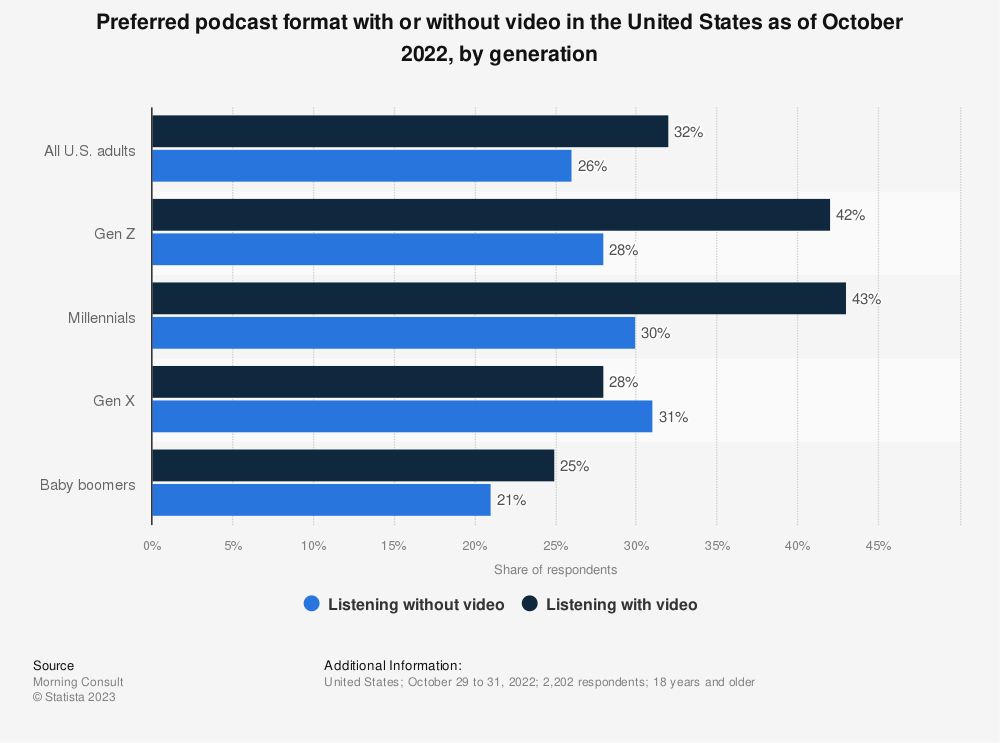
A study by Morning Consult in 2022 found that aside from Gen X, listeners are on board with the video movement within the podcast industry. By a sizable margin.
The blend of auditory and visual elements invites a richer, more immersive experience, fostering a unique connection between hosts and viewers. Let’s recap the main points we’ve explored:
A Brief History: Starting with audio-only formats, primarily through Apple’s iPod, podcasts have evolved to incorporate video. They are growing alongside the technology that has provided enough bandwidth and compression to make video a reality.
The Growth of Video in the Podcast Space: The trend toward video podcasts has seen substantial growth, with platforms like YouTube becoming pivotal in discovery and audience building.
As the second-largest search engine, YouTube offers vast opportunities for content creators to reach wider audiences and monetize their content.
Advantages and Disadvantages: Video podcasts provide enhanced engagement and the ability to use visual aids, potentially attracting a broader audience.
However, they also demand more resources and time in editing. No doubt this process can be daunting for those not comfortable on camera.
Genre Suitability: While some genres, like interviews, product reviews, and visually driven stories, thrive in a video format, others may still prefer the simplicity and intimacy of audio.
Getting Started: For newcomers or those transitioning from audio, start with basic equipment. Then gradually step up your skillset to ease the journey into video podcasting.
Confronting Camera Shyness: Embracing authenticity and understanding that vulnerability can strengthen audience connections are crucial. Practice and a comfortable environment can significantly mitigate on-camera nerves.
Authenticity’s Role: Authenticity isn’t just beneficial – it’s vital. Audiences crave genuine connections, and showing vulnerability only strengthens the bonds between content creators and their viewers.
Remember, you’re never going to please everyone, so be yourself, and you’ll find your tribe. Simple as that.
Think of it like this: video podcasts are like the Swiss Army Knife of content creation. They’ve got everything you need to make your content pop and help you vibe with your audience on a whole new level. It’s the best of two worlds if you can make it work.
So, if you’re sitting there wondering if you should hit that record button and add video to your podcast, the answer is a big, resounding yes.






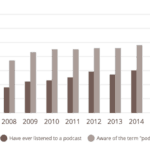



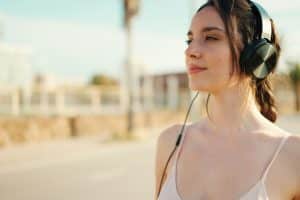


Comments
Comments are closed.